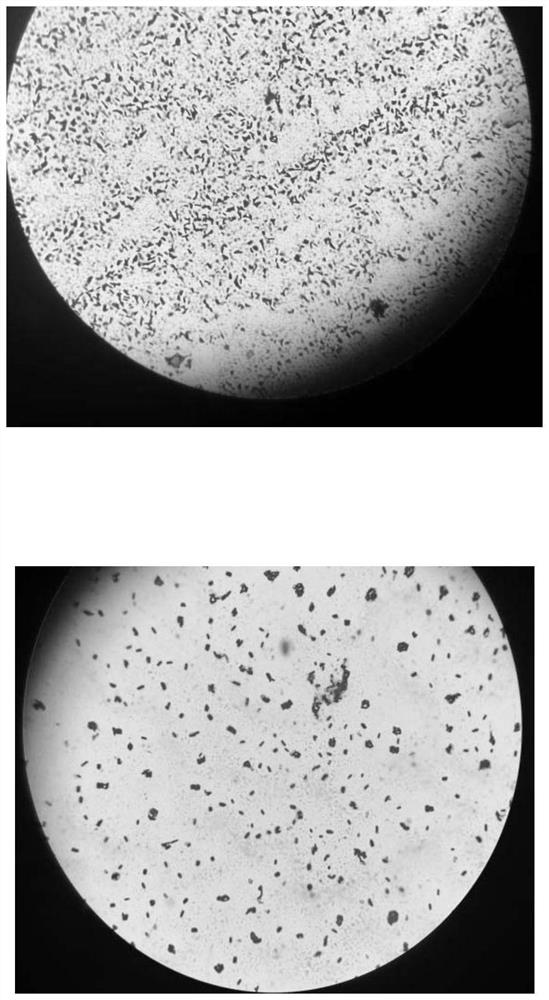A strain of Bacillus licheniformis with high protease production and its fermentative enzyme production method
A technology of Bacillus licheniformis and protease, applied in the direction of microorganism-based methods, biochemical equipment and methods, enzymes, etc., can solve the problems of underutilized feather waste, waste liquid and gas polluting the environment, and difficult to be degraded. The effect of low raw material cost, high process yield and low total production cost
- Summary
- Abstract
- Description
- Claims
- Application Information
AI Technical Summary
Problems solved by technology
Method used
Image
Examples
Embodiment 1
[0044] Example 1, the acquisition, identification and preservation of Bacillus licheniformis GZ73
[0045] Wild bacteria were isolated from the high-temperature fermentation product of feather waste, and then subjected to repeated ultraviolet mutagenesis and nitrosoguanidine mutagenesis, and then a strain was obtained by screening, which was named strain GZ73.
[0046] Morphological characteristics of the strain GZ73: white colonies formed on LB solid medium, round and translucent, smooth in texture, with jagged edges; microscopically, the strain was thin rod-shaped, 0.5-2.0 μm wide, 1.0-9.0 μm long μm.
[0047] Physiological and biochemical characteristics of strain GZ73: positive for catalase, positive for growth NaCl 2%-7%, negative for phenylalanine deamination, positive for most of citrate utilization, negative for lecithinase, positive for casein hydrolysis, positive for starch hydrolysis, Methyl red test negative, glucose acid production positive, glucose gas productio...
Embodiment 2
[0053] Embodiment 2, the stability of bacillus licheniformis GZ73
[0054] Bacillus licheniformis GZ73 was subcultured on solid LB medium plate for several times, the strain obtained from the first passage was named as the F1 generation strain, the strain obtained from the second passage was named as the F2 generation strain, and the strain obtained from the third passage was named as the F2 generation strain. The bacterial strain is named F3 generation strain, the bacterial strain obtained by the fourth passage is named as the F4 generation strain, the fifth passage is named as the F5 generation strain, and the sixth passage is named as the F6 generation strain.
[0055] The tested strains are: F1 generation strain, F2 generation strain, F3 generation strain, F4 generation strain, F5 generation strain or F6 generation strain.
[0056] The test strain was inoculated into the seed medium (the seed medium was the same as in Example 3), and cultured with shaking at 34° C. and 200...
Embodiment 3
[0060] Embodiment 3, the ability of Bacillus licheniformis GZ73 to produce protease
[0061] 1. Preparation of culture medium
[0062] Solid medium: yeast powder 4g / L, peptone 5g / L, glucose 10g / L, beef extract 5g / L, potassium dihydrogen phosphate 10g / L, agar 15g / L, the balance is water; pH7.0-8.0; Sterilize at 121°C for 30 minutes.
[0063] Seed medium: yeast powder 8g / L, maltodextrin 120g / L, peptone 4g / L, corn steep liquor 50g / L, potassium dihydrogen phosphate 11g / L, magnesium sulfate 0.8g / L, the balance is water; pH7. 0-8.0; sterilize at 121°C for 30 minutes.
[0064] Fermentation medium: yeast powder 9g / L, corn flour 120g / L, soybean meal powder 25g / L, corn steep liquor 10g / L, calcium chloride 4g / L, potassium dihydrogen phosphate 12g / L, magnesium sulfate 0.8g / L, Sodium citrate 4g / L, medium temperature amylase, high temperature amylase, the balance is water; pH7.0-8.0. The preparation method of the fermentation medium: put water, corn flour, and soybean meal into the batc...
PUM
| Property | Measurement | Unit |
|---|---|---|
| height | aaaaa | aaaaa |
Abstract
Description
Claims
Application Information
 Login to View More
Login to View More - R&D
- Intellectual Property
- Life Sciences
- Materials
- Tech Scout
- Unparalleled Data Quality
- Higher Quality Content
- 60% Fewer Hallucinations
Browse by: Latest US Patents, China's latest patents, Technical Efficacy Thesaurus, Application Domain, Technology Topic, Popular Technical Reports.
© 2025 PatSnap. All rights reserved.Legal|Privacy policy|Modern Slavery Act Transparency Statement|Sitemap|About US| Contact US: help@patsnap.com



